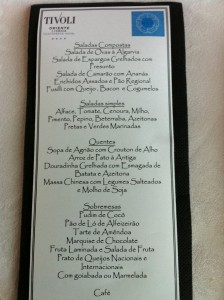I’ve been in Lisboa at SocialNow 2013.
It’s a unique format event, the brainchild of Ana Neves, wherein social tool vendors present their products to a to the senior management (expert panel) of a fictitious company (CableInc) in the presence of an interested audience.
Here are my favourite tweets:
- Manuel Pinhão
@mpinhao 19 Apr@Podio is like a hot girl that smiled at me and wants to go out. Afraid it won’t live up to it but super excited to try - Phil Hill
@philahill 19 Apr surely the role of the new leader is the gathering and shepherding of looser networks, rather than the traditional leader role?
- Ana Silva
@AnaDataGirl 19 Apr “we need tools that enable cooperative work, but most of them today enable collaboration”@stoweboyd - Samuel Driessen
@driessen 19 Apr Remember: for every new communication tools the managers will say ‘people will only use them for gossip’ - Andrzej Marczewski
@daverage 19 Apr One of the biggest changes social tools have brought is switching from push, to pull.@stoweboyd - Pedro Custódio
@pedrocustodio 19 Apr@stoweboyd: The future of work vs the our current present way of working
- Ana Silva
@AnaDataGirl 19 Apr “Yammer will be the social layer for our collaboration platform, integrating Skype, CRM Dynamics, Sharepoint” [Microsoft presentation] - Celine Schillinger
@CelineSchill 18 AprRT
@driessen@pedrocustodio@podio: We’re in 2013, the spreadsheet is STILL the most broadly used collaboration tool at work - Hans-Juergen Sturm
@hjsturm 18 Apr A challenge for all providers is the integration and at the same time separation of internal + external facing content. - Pedro Custódio
@pedrocustodio 18 Apr “@carvalhop: Everyone is trying to kill email at#SocialNow” indeed, shouldn’t we get over it and embrace it as part of whatever solution? Pedro Custódio @pedrocustodio 19 Apr@spreadd shows that we better off with work tools that play along our processes than the ones trying to change the way we work - Stowe Boyd
@stoweboyd 18 Apr Baking your organizational structure into the information you want to share is a terrible idea#socialnow even if its in an open source tool - Bruno Figueiredo
@BrunoFigueiredo 18 Apr When you design to accomodate all edges you lose focus from the center. The center is where 95% of your customers are. Bruno Figueiredo The best tools are the ones who remove the burden of choice for the user and present him with thoughtful defaults.
And a few tweets from me:
@stoweboyd idea of future archetypes compelling. World of tomorrow: Freelancers, Generalist, Followers and Cooperators
- Evernote aspires to be ‘the guy in the business everyone goes to for knowledge’
- Emanuele Quintarelli
@absolutesubzero 18 Apr RT@pauljcorney: ‘failure is brilliant because it teaches us what to do next time” By 2015 50% of innovation processes gamified @WordPress collaboration tool ‘so easy my mom could use it’ And P2 is FREE. I love the idea of ‘the watercooler’ page recognising the importance of it as the meeting point for serendipitous conversations@spreadd – an activity tracker that creates profiles of workers with tags (wordle).- And finally from a conversation around the value of neutral objects to stimulate discussion Paul J Corney
@PaulJCorney 18 Apr#socialnow Vodafone Gaming results – debate around workflow priorities created an opportunity for change- Ana Neves
@ananeves 18 Apr it is easier to discuss “points” than discussing the way they work on a day to day, says@carvalhop << LOVE THIS!Paul J Corney @PaulJCorney 18 Apr@ananeves@carvalhop Because they are neutral objects – x refer to work on use of objects as triggers for storiesAna Neves @ananeves 18 Apr.@PaulJCorney@carvalhop v true!@snowded uses “personas” so that debate can be less threatning, still tackling elephant in room
- Ana Neves
It being Portugal where food and wine are essential for networking it had to be first class and it was – this is the Day Two lunch menu!
If you’d like to see the #socialnow twitter streams I consolidated them into a Storify account which you can find here.






Pingback: Links for April 22, 2013 | Andrzej's Links
Hi Paul,
Conferences about the future usually emphasize “stop this” and “do that instead” statements (which rarely turn out to be the actual path taken, but help to feed the evolution to inclusion of diversity and alternatives). It is important that we continue to develop new ways (of stimulating people to people interactions, processes that enhance outcomes from these and tools that make them efficient across time & geography) and conferences are great for accelerating that (because they put people face to face in a creative, non distracting environment).
The big “however” is that we focus on “stop” & “start” and forget “continue”. Rarely does the work. It is difficult enough to implement change by integrating a new option, let alone throwing out everything one is comfortable with already. Of course some things need to be phased out over time and “two sources of truth” becomes messy. A more optimal way forward is blended introduction over time as pilots with strategic migration. The sudden stop option usually ends in great knowledge loss and lower performance.
You make a good point Arthur. I was struck by this principle in Taleb’s new book AntiFragile as quotes by John Hagel:
(11) Respect the old
Taleb argues that “antifragility implies . . . that the old is superior to the new. . . . What survives must be good at serving some (mostly hidden) purpose that time can see but our eyes and logical faculties can’t capture.” Only the antifragile survives and thrives; the fragile is ultimately exposed by time and history.
http://edgeperspectives.typepad.com/edge_perspectives/2013/04/getting-stronger-through-stress-making-black-swans-work-for-you.html
The same argument is put by Keagan in Immunity to Change but with a slightly different angle: what’s old is serving some mostly hidden purpose but it can be holding you back.